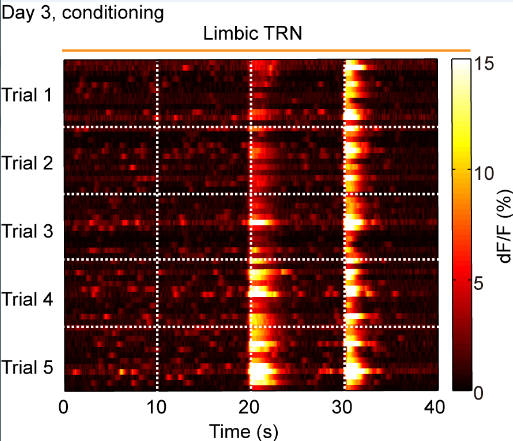The research team led by Prof. Xiaoming Li has recently published an article titled A novel cortico-intrathalamic circuit for flight behavior on Nature Neuroscience online on April 29th at 23pm, Beijing time. This research uncovered a neural circuit from cortex to thalamus mediated by Thalamic reticular nucleus(TRN) which is involved in regulating flight behavior induced by fear. More importantly, this research is a remarkable breakthrough for understanding flight behavior but also sheds light on the circuit underlying post‐traumatic stress disorder(PTSD) on the aspect of concept, leading to a new direction of this field.
Graduate students Ping Dong and Hao Wang from Zhejiang University School of Medicine are co-first authors of this article and Prof. Xiaoming Li from Zhejiang University School of Medicine is the corresponding author.
Fear is a kind of emotion that arises when animals are faced with life-threatening stimuli. For animals, rapid and effective reaction is a key to keep the species living on and continuing. In the long time of evolution, when facing different environment, animals would acquire different action strategy to adapt. For example, when we define a stimulus as controllable or avoidable, we tend to take active defensive strategy, flight. On the contrary, when the stimulus is uncontrollable and unavoidable, passive strategy, freezing, is always employed.
TRN isa shell-shaped nucleus located between the cortex andthalamus. This nucleus is called as “reticular” because of the axons projecting between cortex and thalamus forming reticular complex with TRN. This nucleus functions as the ‘gateway guardian’ in filtering information betweenthe cortex and thalamus and has been implicated in selective attention and sleep. However, the subregion of TRN and the relation between its neural circuit and fear flight remains unclear.
To solve this problem, researchers from the team led by Prof. Li first discovered the relation between PV expressing GABAergic neurons in limbic TRN and flight. Then they employed the optogenetic method to inhibit the activity of PV expressing neurons in limbic TRN and found that mice froze in face of stimulus instead of choosing flight. When activating this population of neurons, defensive flight and jumping would arise in mice. This results showed the important role of PV expressing neurons in limbic TRN in defensive flight.
So what is the neural circuit mechanisms of the PV expressing neurons regulating defensive flight induced by fear? In the following experiments, researchers utilized anterograde and retrograde tracing virus to find the upstream and downstream of neurons of this population, which are cingulate cortex(Cg) and intermediodorsal thalamus nucleus(IMD) respectively. Through activating the circuit from Cg to limbic TRN, neurons in IMD could be inhibited and the excitatory input to amygdala decreased, which prompted defensive flight behavior in animals.
Reviewers of Nature Neurosciencethink highly of this research. “This is nice study with novel and unexpected findings, which demonstrate a key role of the cingulate ctx(Cg)-TRN-MD circuit in mediating flight and freeze behavior in a conditional fear paradigm. Bi-directional optogenetic experiments nicely complement and confirm each other and support the conclusion. The data are expected to make a great impact since outside the amygdala-PAG circuit other “upstream” regions have not been investigated in this paradigm”.
This research received important help from Prof. ShuminDuan, academician of CAS, Prof. Jiadong Chen, Prof. Hao Wang from Zhejiang University and Prof.Fuqiang Xu from Wuhan Institute of Physics and Mathematics, CAS and was supported by the State Key Program Of National Natural Science of China and ‘Neural Circuit Foundation of Emotions and Memory’ Major Project and so on.
Link of the article: https://doi.org/10.1038/s41593-019-0391-6
This is the third breakthrough made by team led by Prof. Li this year and published on international top publications. In this January, research about the function of aversive circuit in depression and reward circuit involved in addiction were published on Nature Medicine and Neuron, leading to wide concerns from society.
Prof. Xiaoming Li from Zhejiang University School of Medicine is Chang Jiang Scholars Distinguished Professor, receiver of National Science Foundation for Distinguished Young Scholars of China. His lab focuses on research about emotions and neural circuit mechanisms of related disorders and has acquired important achievements in structures and regulating functions of synapses and neural circuits, especially in fields of pathogenesis of schizophrenia and depression. Representative articles were published on international famous publications including Nature Medicine, Nature Neuroscience and Neuron, Prof. Li as corresponding author, and were praised highly by peers. Besides, Prof. Li received the second prize in China's State Natual Science Award and the first prize in Provincial Scientific Technological Progress Prize.






 Location :
Location : 

